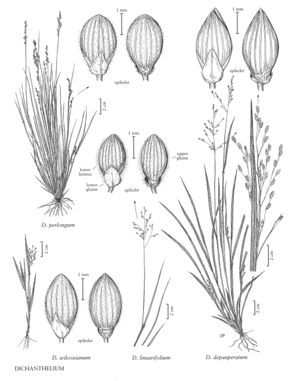Dichanthelium wilcoxianum
Plants cespitose. Basal rosettes poorly differentiated; sheaths glabrous; blades 2-4 cm, narrow, similar to those of the lower cauline leaves, ascending to spreading. Culms 15-35 cm, stiffly erect, all but the upper 2-4 internodes very short; nodes glabrous or with weak, reflexed hairs; internodes purplish-gray, sparsely pubescent; fall phase developing early, forming erect branches from the lower or midculm nodes, each branch terminating in a partially included panicle of 8-16 spikelets, no sterile shoots formed. Cauline leaves usually 3; sheaths hirsute, hairs papillose-based; ligules 0.5-1 mm; blades 4-8 cm long, 2-5 mm wide, all alike, stiffly erect, green to grayish-green, flat, not plicate, sparsely pilose. Primary panicles 3-5 cm long, 2-4 cm wide, ovoid, open, shortly exserted, with 12-32 spikelets; branches short, stiff, spreading; pedicels mostly 4-8 mm, spreading. Spikelets 2.4-3.2 mm long, 0.7-1.2 mm wide, ellipsoid to obovoid, often reddish throughout, short-pubescent. Lower glumes 0.7-1.2 mm, triangular; upper glumes and lower lemmas about equaling the upper florets; upper florets 1.9-2.5 mm, ellipsoid, pointed. 2n = 18.
Distribution
Alta., Man., Sask., Colo., N.Mex., Mont., Minn., Wis., Kans., N.Dak., Nebr., S.Dak., Ill., Ind., Iowa, Okla., Wyo.
Discussion
Dichanthelium wilcoxianum grows in dry prairies, especially in sandy or gravelly openings. It is restricted to the Flora region. The primary panicles, which are produced from mid-May to early June, are partially open-pollinated; the secondary panicles, which are produced in June, and occasionally also in September, are cleistogamous.
Some specimens of Dichanthelium oligosanthes subsp. scribnerianum from the southern Great Plains that have prematurely elongating upper internodes resemble D. wilcoxianum, but they have greenish spikelets that are 1.7-2.4 mm wide, an orange spot at the base of the glumes, and larger basal rosettes.
Selected References
None.
